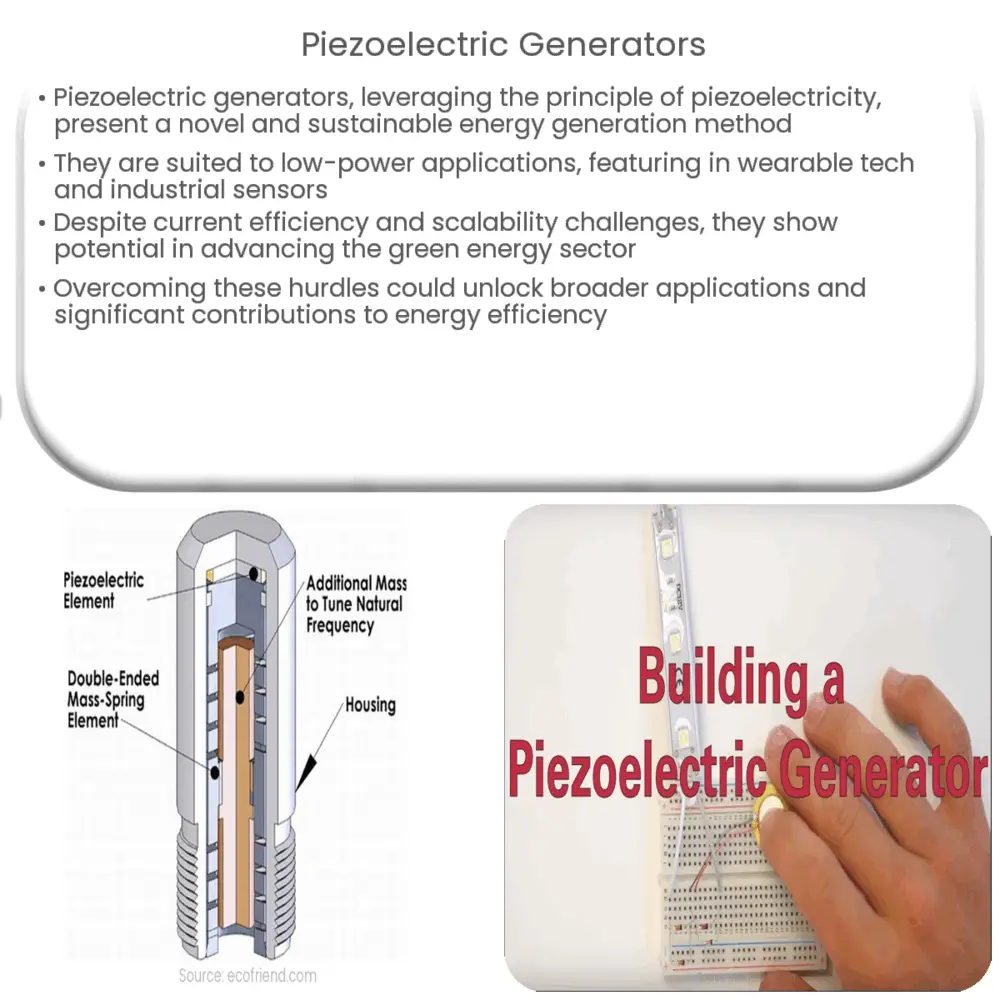Explore the potential of piezoelectric generators, an innovative technology for sustainable energy generation, its applications, challenges, and future prospects.

Piezoelectric Generators: The Future of Energy
The world of energy generation is evolving at an unparalleled pace. Amidst this progress, one technology that stands out is the piezoelectric generator. Harnessing the principles of piezoelectricity, these generators offer an innovative and sustainable way to generate power.
Understanding Piezoelectricity
Before diving into piezoelectric generators, it’s essential to understand the principle they’re based on – piezoelectricity. This phenomenon, derived from the Greek word ‘piezein’, which means to squeeze or press, was discovered in 1880 by the Curie brothers, Pierre and Jacques. They noticed that certain materials, such as quartz and Rochelle salt, generated an electric charge when subjected to mechanical stress. This principle is behind the workings of piezoelectric generators.
Piezoelectric Generators: A Closer Look
- Design: A piezoelectric generator uses piezoelectric materials, which are often in the form of a thin film or layer. When these materials undergo mechanical deformation – such as being compressed, twisted, or bent – they generate an electric charge.
- Operation: The mechanical stress applied to the piezoelectric material can come from various sources, including human motion, low-frequency vibrations, or even sound waves. The generated electric charge is then harvested and stored, serving as a power source for electronic devices.
It’s worth noting that while piezoelectric generators can convert mechanical energy into electrical energy, the output is usually quite small. Therefore, they are more suited to low-power applications.
Applications of Piezoelectric Generators
- Wearable Technology: Piezoelectric generators have found a place in the field of wearable technology. They can be incorporated into shoes or wristbands to generate electricity from the user’s movements, powering small devices like watches or fitness trackers.
- Industrial Sensors: In the industrial sector, piezoelectric generators can power sensors and other small electronic devices in hard-to-reach or hazardous locations, eliminating the need for battery replacement.
These applications showcase the potential of piezoelectric generators to contribute to a more sustainable energy future. However, the technology is still in its early stages and faces significant challenges that need to be addressed.
Challenges and Future Prospects
- Efficiency: Currently, one of the main challenges of piezoelectric generators is their low efficiency, especially when compared to other forms of energy generation. For them to become a viable source of power, advancements in material science and technology are required to increase their power output.
- Scalability: Piezoelectric generators work well on a small scale, but scaling them up for larger applications poses significant challenges. Solutions need to be found to make piezoelectric generators more flexible and adaptable to a wide range of applications.
Despite these challenges, the future of piezoelectric generators looks promising. The constant drive towards greener and more sustainable energy sources is pushing the boundaries of this technology, and piezoelectric generators have the potential to become a significant player in the energy sector.
Conclusion
In conclusion, piezoelectric generators, based on the principle of piezoelectricity, offer an innovative and potentially sustainable method of generating electricity. While they are still in their infancy and face challenges such as low efficiency and scalability, they show promise in certain applications such as wearable technology and industrial sensors. As the push for sustainable and green energy solutions continues, the future development and advancement of piezoelectric generators could pave the way towards a more energy-efficient world. The key to their success will lie in overcoming the challenges that currently limit their broader application and maximizing the potential of this unique form of energy generation.

